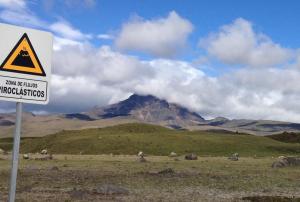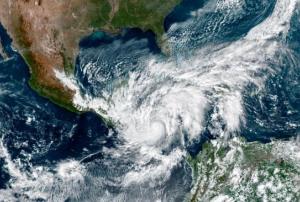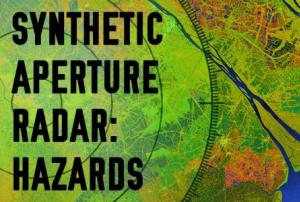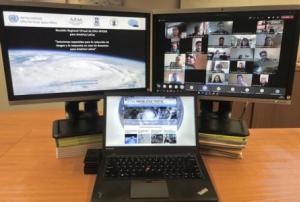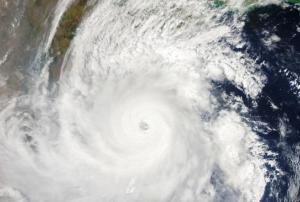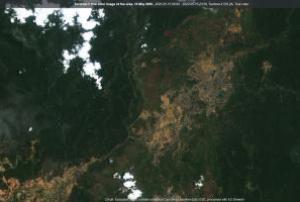Landslide
Definition
Facts and figures
Further information
UN-SPIDER Regional Support Offices with hazard-specific expertise
Related content on the Knowledge Portal
The use of multi-risk information systems is crucial in confronting the increasing risks posed by natural hazards. In some cases, risk is increasing due to inadequate land-use norms or regulations that allow for the construction of infrastructure in areas exposed to such natural hazards. In other cases, vulnerability increases due to lack of awareness or extreme poverty. The need to address risks from the point of view of multiple hazards is necessary to contribute to sustainable development and has been incorporated as an essential element of the Sendai Framework for Disaster Risk Reduction 2015-2030. For this purpose, the RIESGOS 2.0 project was launched in March 2021. Under the coordination of the German Aerospace Center (DLR), the project builds on the accomplishments of its predecessor - RIESGOS - as a multi-risk information system that models and simulates natural…
read more17/03/2021A new report by the world’s largest humanitarian aid network highlights global disasters, populations most vulnerable to them and the efforts of local institutions in preventing, preparing for and responding to them. The 2020 edition of the World Disasters Report, “Come Heat or High Water”, was launched virtually from the offices of the International Federation of Red Cross and Red Crescent Societies (IFRC) in Vienna on November 16. This year’s report discusses climate- and weather-related disasters and their humanitarian impact. It argues for the usefulness of smart financing and space-based information in disaster management support.
The report warns that the global effort to address climate change is leaving behind…
read more19/11/2020The hurricane season in Central America normally quiets down at the end of October, but this year is one of those rare years when tropical storms and hurricanes in the region have occured beyond the typical season. With 30 events thus far, the 2020 tropical storm season in the Caribbean continues to take its toll in developing countries in Central America. Hurricane Eta entered the west coast of Nicaragua on 3 November as a Category 4 hurricane – the second-highest classification category. It triggered massive floods in Nicaragua, Honduras and Guatemala. In some regions, the magnitude of these floods was similar to those triggered by Hurricane Mitch in 1998, which devastated the region and killed more than 35,000 people throughout Central America. Fortunately, the consequences of Hurricane Eta were much smaller.
UN-SPIDER has been supporting disaster response efforts to Hurricane Eta at the request of the…
read more16/11/2020The University of Alaska Fairbanks has launched a MOOC about Synthetic Aperture Radar (SAR) remote sensing for disaster monitoring. SAR is a remote sensing technology that can see the ground even during darkness and through rain, clouds, or smoke. Participants of the course will gain an intuitive understanding of the information contained in SAR observations and learn to use a range of analysis techniques to apply SAR data to disaster mapping and management. Specific topics will include:
- The mathematical and physical principles of SAR remote sensing
- How to access and visualize SAR data
- Interpretation of SAR images in the context of disaster monitoring
- Interferometric SAR (InSAR) concepts
- Flood mapping and SAR change detection for hazard analysis
- InSAR-based analysis of volcanoes and landslides
The learned concepts will be put into practice in simulated disaster response exercises, in which participants will analyze SAR…
read moreIn order to discuss and promote the use of space technologies in addressing natural hazards such as forest fires and landslides in Latin America, UN-SPIDER conducted a virtual regional expert meeting on the topic of “Space-based Solutions for Disaster Risk Reduction and Emergency Response in Latin America” from 22 to 24 September 2020. The meeting was jointly organized with UN-SPIDER Regional Support Offices from Argentina (National Space Activities Commission, CONAE), Brazil (Federal University of Santa Maria, UFSM), Colombia (Geographic Institute Agustin Condazzi, IGAC), and Mexico (Mexican Space Agency, AEM).
In Latin America, UN-SPIDER and its Regional Support Offices have regularly carried out regional expert meetings, training courses and other joint efforts since 2011. The last Regional Expert Meeting took place in 2017 in Mexico.
The meeting, which consisted of three two-hour-long sessions, brought together a total of over 200 disaster management stakeholders…
read more28/09/2020En décadas recientes muchas comunidades en América Latina y el Caribe han experimentado desastres ocasionados por inundaciones, sequías, deslizamientos, terremotos, erupciones volcánicas y maremotos o tsunamis que han erosionado los logros asociados a procesos de desarrollo. Además, en este año 2020 la pandemia ocasionada por el virus COVID-19 ha impactado a muchos países del mundo, forzando a los gobiernos, al sector privado, a la sociedad civil y a organismos regionales e internacionales a modificar sus planes de trabajo. De manera paralela, varios países del Este de África, del Sudoeste de Asia y de América Latina están experimentando los impactos de la plaga de langosta.
Convencidos que las tecnologías espaciales pueden jugar un papel preponderante en apoyar los esfuerzos que llevan a cabo las instituciones en materia de gestión para la reducción de riesgos, la preparación, la respuesta y la recuperación en caso de desastres; la Asamblea General de las…
read moreRegional Support Offices mentioned:The Argentinean SAOCOM 1B satellite [was successfully launched](https://www.argentina.gob.ar/noticias/argentina-lanzo-el-satelite-saocom-1b-y-completo-la-mision-espacial-mas-importante-del-pais) into orbit on 30 August 2020. Developed by the National Argentinean Space Commission (CONAE), this new satellite will join SAOCOM 1A and four Italian COSMO-SkyMed to complete the joint Italian-Argentinean Satellite System for Emergency Management (SIASGE). Like its predecessor, SAOCOM 1B was built in Argentina through a joint effort with private companies and universities. It will operate at an elevation of 620 kilometers above the surface of the Earth. A SpaceX Falcon 9 booster launched the satellite from Space Launch Complex 40 at Cape Canaveral Air Force Station in Florida, United States of America. The SAOCOM 1B satellite has been fitted with a Synthetic Aperture Radar (SAR) sensor that makes use of microwaves in the electromagnetic L-band, which goes through clouds and works without…
read more14/09/2020The training date is in the past. However, videos and resources of the training can be accessed here.
Synthetic Aperture Radar (SAR) data can be acquired day and night, even in cloudy conditions, providing a dense time-series suitable for trend analysis and change detection. Environmental applications for SAR data include:
- forest inventory, biomass estimation and condition monitoring
- emergency response to floods and landslides
- habitat and crop mapping
- soil moisture monitoring
- offshore infrastructure and vessel monitoring
- detection of pollution such as oil spills and illegal waste
The Joint Nature Conservation Committee (JNCC) is organising a series of online training sessions on understanding, accessing…
read moreAccording to the latest issue of an annual disaster statistics report, floods were the deadliest type of disasters in 2019, followed by extreme temperature, while storms affected the highest number of people. Published by the Centre for Research on the Epidemiology of Disasters (CRED), “Natural disasters 2019 - Now is the time to not give up” draws on data recorded in the Emergency Events Database (EM-DAT), which saw the addition of 396 disasters that affected a total of 95 million and caused $103 billion in economic losses around the world.
Accounting for 40 per cent of disaster events, Asia suffered the highest impact with 45 per cent of deaths and 74 per cent of total affected. India, which saw cyclone Fani cause destruction in 2019, was the country most…
read more20/08/2020A landslide in northern Myanmar has left at least 162 dead, according to the Myanmar Fire Service Depart. At least 43 people have been injured, and an unknown number are missing. Search and rescue operations are on-going.
UN-SPIDER has supported the DDM Ministry of Social Welfare, Myanmar, in activating the International Charter Space and Major Disasters for obtaining information products related to the landslide. The International Centre for Integrated Mountain Development (ICIMOD), a UN-SPIDER Regional Support Office, is acting as project manager for this activation of the Charter. The table below provides the link to the Charter activation page as well as to information products created by other organizations.
read moreSource Title URL International…

